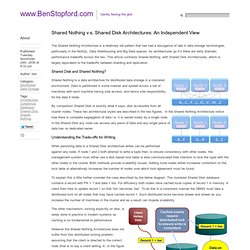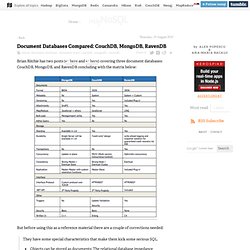

Unbiased, Data-Driven Comparisons. Www.BenStopford.com » Blog Archive » Shared Nothing v.s. Shared Disk Architectures: An Independent View. The Shared Nothing Architecture is a relatively old pattern that has had a resurgence of late in data storage technologies, particularly in the NoSQL, Data Warehousing and Big Data spaces.

As architectures go it’s there are fairly dramatic performance tradeoffs across the two. This article contrasts Shared Nothing with Shared Disk Architectures, which is largely equivalent to the tradeoffs between sharding and replication. Shared Disk and Shared Nothing? Shared Nothing is a data architecture for distributed data storage in a clustered environment. Data is partitioned in some manner and spread across a set of machines with each machine having sole access, and hence sole responsibility, for the data it holds.
By comparison Shared Disk is exactly what it says; disk accessible from all cluster nodes. In the Shared Disk any node can access any piece of data and any single piece of data has no dedicated owner. Understanding the Trade-offs for Writing Considering the Retrieval of Data. Document Databases Compared: CouchDB, MongoDB, RavenDB. Brian Ritchie has two posts (☞ here and ☞ here) covering three document databases: CouchDB, MongoDB, and RavenDB concluding with the matrix below: But before using this as a reference material there are a couple of corrections needed: They have some special characteristics that make them kick some serious SQL.Objects can be stored as documents: The relational database impedance mismatch is gone.

Just serialize the object model to a document and go.Documents can be complex: Entire object models can be read & written at once. No need to perform a series of insert statements or create complex stored procs.Documents are independent: Improves performance and decreases concurrency side effectsOpen Formats: Documents are described using JSON or XML or derivatives. Clean & self-describing.Schema free: Strict schemas are great, until they change. Related to the matrix comparison: Versioning is not supported by either MongoDB and CouchDB.
By Alex Popescu & Ana-Maria Bacalu Most read Latest. Traditional database design vs. key-value table. Consider the following two scenarios: Scenario no. 1 – traditional database design method The DBA will use the following SQL statements in order to create two additional columns: In our example, we will update the data that already exists in the table with the following update sql statements: This will make our table look like this: We might want to be able to make a new descriptive change without altering the database schema structure.

Scenario no. 2 – use of key-value table The following scenario describes a generic approach to the challenge. The DBA can create an additional table which will hold any additional information that describes the employee better. Updating existing data in our example can be done using the following insert sql statements: This would yield the following table: This information is stored in a more generic structure, allowing the programmer to add employee attributes on his own as well as create a mechanism that adds employee attributes at run-time. Eric Evans' Weblog. NoSQL Relational Database Management System: Home Page. A Relational Database Management System NoSQL is a fast, portable, relational database management system without arbitrary limits, (other than memory and processor speed) that runs under, and interacts with, the UNIX1 Operating System.

It uses the "Operator-Stream Paradigm" described in "Unix Review", March, 1991, page 24, entitled "A 4GL Language". There are a number of "operators" that each perform a unique function on the data. The "stream" is supplied by the UNIX Input/Output redirection mechanism. Therefore each operator processes some data and then passes it along to the next operator via the UNIX pipe function.
What is NoSQL NoSQL, which I personally like to pronounce as noseequel2, is a derivative of the RDB database system. Other major contributors to the original RDB system, besides Walter Hobbs, are: Chuck BushDon EmersonJudy LenderRoy GatesRae Starr People who helped with turning RDB into NoSQL: The NoSQL logo was kindly provided by Kyle Hart. NOSQL Databases. Bases de datos NoSQL y escalabilidad horizontal. Alicante, 24 de marzo de 2011 - ¿Cómo almacena sus datos Twitter?

, ¿Facebook? , ¿Google? A medida que las TIC avanzan e Internet se hace más ubicua, surgen muchos proyectos cuya cantidad de datos hace inviable el uso de bases de datos relacionales. La respuesta a la necesidad de gestionar volúmenes masivos de información surge de la base de datos NoSQL, término acuñado a finales de los 90 y que engloba todas las tecnologías de almacenamiento estructurado que no cumplen el esquema relacional. La cantidad de información manejada por comunidades, redes sociales, buscadores, y muchos otros proyectos en el ámbito de la Web 2.0 es abrumadora, lo que ha hecho que surjan nuevas arquitecturas de almacenamiento de información, que deben ser de alto rendimiento, escalables y distribuidas.
Dentro de las plataformas NoSQL encontramos varios grupos: Basadas en clave/valor.